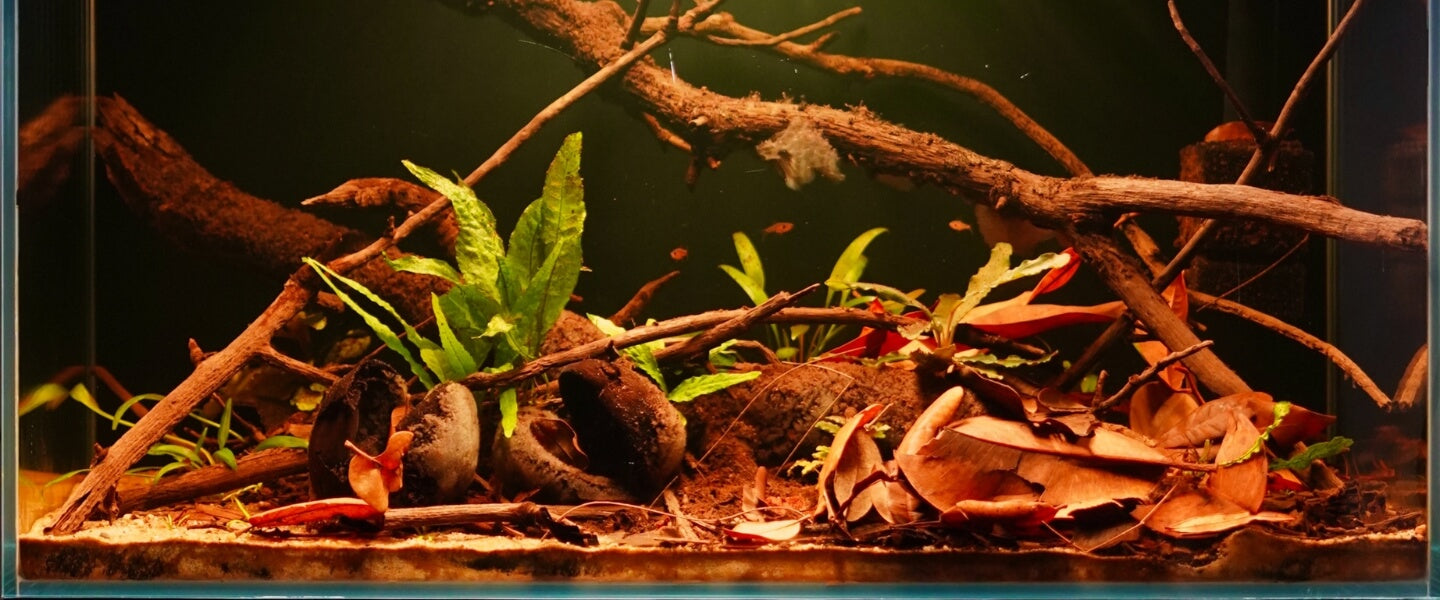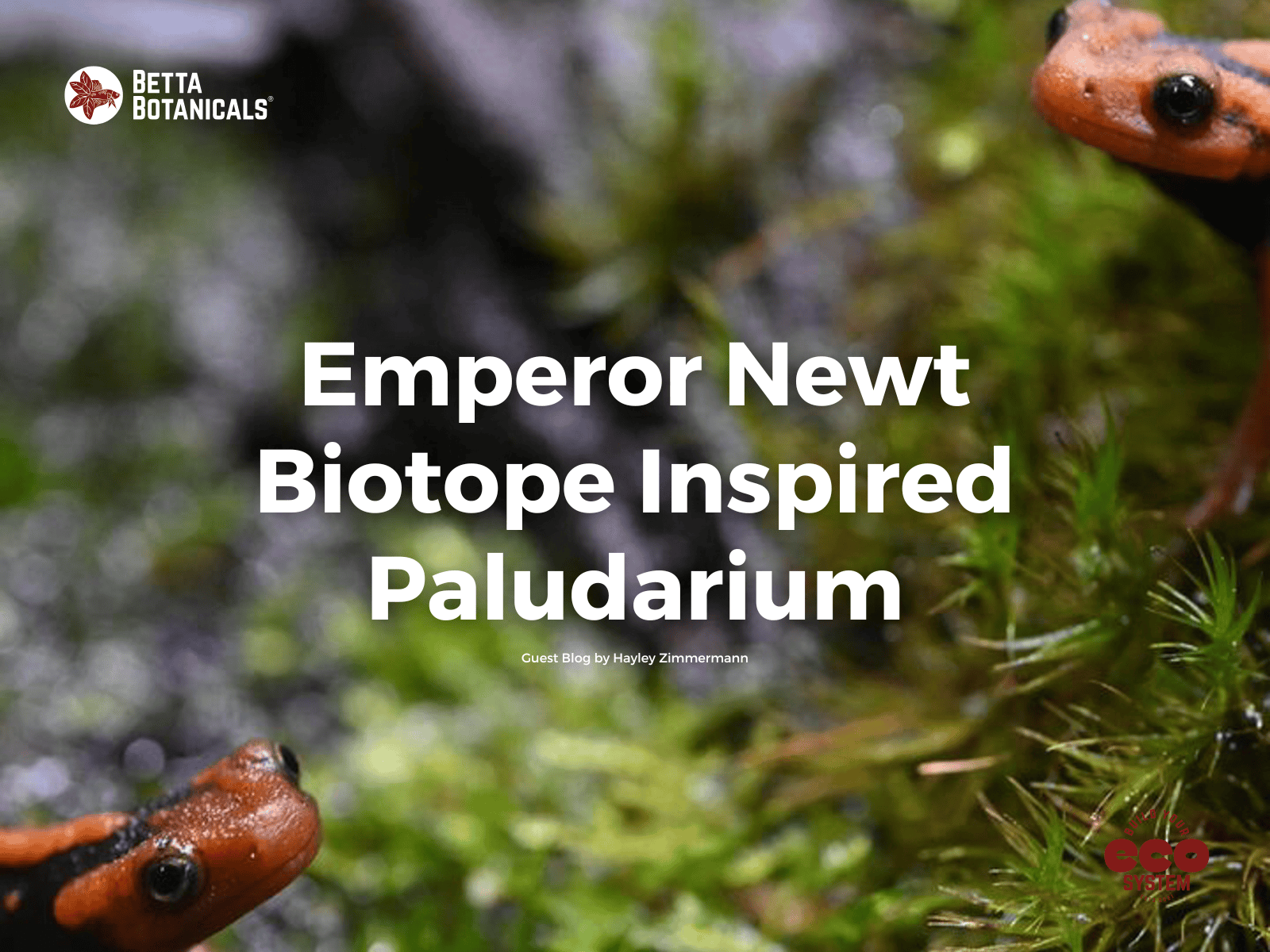
Understanding the 4 Kinds of Biotope Aquariums: A Technical Guide to Natural Habitat Replication in the Fish Room
How exactly would you replicate the natural habitat of a domestic betta? Unfortunately you can't, as they don't exist in nature. But another popular aquarium fish, the neon tetra, can be replicated! How? by creating its habitat-specific biotope. Biotope aquariums offer a unique opportunity to recreate specific natural habitats, allowing us to observe aquatic ecosystems as they may exist in the wild. By emulating exact conditions—including water parameters, substrate composition, vegetation, aquatic botanicals and even the distribution of light—biotope aquariums provide an immersive experience that requires consideration beyond the glass pane.
At times, the aquarist community engages in debates about the purity of biotope aquariums - just look at the comment section on instagram. Some enthusiasts strive for absolute authenticity, meticulously replicating every aspect of the habitat. Others, like me, prefer a more flexible interpretation—balancing practicality, finances, and supply with the desire to create a natural-looking environment by calling it Biotope Inspired. Balancing scientific accuracy with visual appeal can be challenging, but that’s part of the fun, isn’t it?

Habitat inspiration from the Sumatran blackwater peat swamps of Betta Sp. Jade.

Leaf litter, grasses, and maroon water color of Betta Sp. Jade Habitat in Sumatra.
The Definition of a Biotope Aquarium
A biotope aquarium is more than just a collection of fish and plants; it’s a holistic representation of a natural ecosystem as you could find in nature. Each natural element is carefully selected to reflect the precise conditions of a specific locale, whether it’s the sandy-bottomed streams of the Amazon Basin or the peaty swamps of Southeast Asia. Creating such an environment involves extensive research and attention to detail. Biotope aquarists strive to match not only the species of flora and fauna but also environmental factors like pH levels, water hardness, flow rates, water level, food choices, and even the type of leaf litter you’d find in the habitat. The biotope aquarium can contain botanicals, but not always. It can be tinted...but not always. They contrast with blackwater aquariums - which must match a specific water chemistry, and it contrasts with botanical method aquariums - which fosters a functioning ecosystem without adherence to location or water chemistry.

@artoftint Borneo Biotope | a very strict fish species biotope with geographic biotope plants. Water chemistry, botanicals & tint is accurate to the habitat.
I remember when I first added catappa leaves to my aquarium, thinking I’d hit the big leagues. Then I discovered the world of biotope aquariums and realized there was so much more to explore—kind of like finding a hidden river branching off from the main stream.
The Scientific Foundations of Creating a Biotope Aquarium
Understanding the scientific principles behind biotope aquariums is essential for accurate replication. Ecology, the study of interactions between organisms and their environment, serves as the foundation for this endeavor. An ecosystem comprises both biotic (living) and abiotic (non-living) components interacting within an environment. In a biotope aquarium, these interactions are replicated on a smaller geographic scale, emphasizing the relationships between species and their habitats.

You cannot always control the aquatic hyphomycetes in the biotope aquarium, but you must embrace their presence as they are a crucial component & methodology of maintaining the ecosystem
Biotic Components of the Biotope Aquarium
• Fauna: Fish, invertebrates, and microorganisms native to the habitat you’re replicating.
• Flora: Native aquatic plants and algae that coexist with the fauna, providing shelter and contributing to the ecological balance.

A bucket of RO water can be conditioned with Biotope specific botanicals & peat to help replicate conditions during water exchanges.
Abiotic Components of the Biotope Aquarium
• Water Chemistry: Parameters like pH, hardness, temperature, and dissolved oxygen levels.
• Substrate and Décor: Sand, gravel, rocks, driftwood, and—yes—leaf litter/seed pods/cones that recreate the physical environment.
• Light and Flow: Mimicking natural light cycles and water flow patterns affects the behavior and health of aquatic organisms.
Types of Biotope Aquariums you could Recreate at Home
Biotope aquariums can be categorized based on the specificity of the habitat they replicate:
• Geographic Biotopes: Represent larger geographical regions, capturing the building blocks of a broad area without focusing on every tiny detail.

A Geographic South American Biotope 'inspired' Aquarium. Botanicals are sourced from Peru. All fish & Plants are from South America. However; the manzanita wood is from Texas - hence 'inspired'. You'd hear me simply reference this as a 'Biotope-Inspired Aquarium'
• Habitat-Specific Biotopes: Focus on a precise location, replicating exact conditions and endemic species. This might involve going down a research rabbit hole—and loving every minute of it.

Again...another 'inspired' Biotope Aquarium... All botanicals from Indonesia, some of the wood as well, but not the Manzanita branches or substrate. The fish can all be found in the same river habitat locale - some are wild caught and imported from the same area.
• Ecological Niches: Replicate microhabitats within a larger habitat, such as blackwater tributaries or tidal mangrove swamps. Hobbyists will often replicate an ecological niche biotope aquarium from a photograph provided by a researcher, botanist, or ichthyologist.

While not an aquarium - this habitat photo for Bintan bangka serves as direction for a Niche Biotope Aquarium. A shallow aquarium with a rich substrate using coconut coir, layers of jambolan leaves, macaranga, and longan. A low pH (sub 5), and a small internal filter.
Building Your Biotope Ecosystem
Creating a biotope aquarium involves several steps, but trust me, it’s worth it.
Research and Planning: Start by selecting the habitat you wish to replicate. Dive into the specifics—water chemistry, native species, climate, and ecological interactions. Understanding parameters like pH levels, water hardness, and temperature ranges is essential.

Underwater photo of Betta Burdigala habitat in Sumatra shows shallow water depth, an abundance of leaf litter, and in this case clear water!
Setting Up the Aquarium: Choose an appropriate tank size that suits your chosen habitat and its inhabitants. Adjust water parameters to match natural conditions, often using reverse osmosis (RO) water and natural additives like peat or botanicals to achieve that perfect tannin-stained look. However, not all biotopes are tinted! You may need to take that RO water and remineralize it to the hardness of shell dwellers from an African Lake. Selecting the right substrate and décor is vital. Use materials such as sand, gravel, rocks, driftwood, and leaf litter that represent the habitat. This might be the time to “leaf” the detritus alone and let nature do its thing, as we want the substrate to enable the fish to exhibit their natural behaviors.

The foundations of a leaf litter bed using Jambolan leaves from Indonesia.
Introducing Flora and Fauna: Add plants and animals native to your chosen habitat. Remember, it’s about building an ecosystem, so every addition should contribute to the overall balance. Allow time for the ecosystem to establish itself; biological filtration needs to develop before introducing sensitive species.
The Benefits of Biotope Aquariums
Biotope aquariums offer significant educational value, serving as living models for studying ecological principles, species interactions, and environmental science. They provide unique insights into biodiversity, allowing you to understand the variety of life within specific habitats - I've been loving the interactions found in my South American and South East Asian Biotope Inspried Aquariums. Observing natural behaviors that may not be evident in general aquarium setups offers a deeper appreciation of aquatic life, and the easiest one - in my opinion - is the behavioral differences of corydoras when kept on sand, instead of gravel.
These aquariums also raise environmental awareness, especially when they replicate threatened habitats - like Betta Hendra. By showcasing delicate ecosystems, they draw attention to issues like deforestation, pollution, and climate change, inspiring conservation efforts and encouraging responsible aquarium practices.
Beyond education and conservation, there’s something uniquely captivating about an aquarium that mirrors nature so closely. It’s not just a tank; it’s a window into another world. The natural harmony of a well-designed setup provides a sense of connection to nature and can be a source of relaxation and inspiration - especially when you couldn't travel to the location yourself.
Challenges and Considerations when Building a Biotope Aquarium
While rewarding, biotope aquariums present challenges:
Ethical Sourcing: Ensuring that all plants and animals are obtained responsibly is crucial. This means avoiding wild-caught endangered species and opting for captive-bred specimens to reduce pressure on natural populations. Using sustainable materials for décor and substrates helps minimize environmental impact. The largest hobbyist debate is in regard to the use of peat... more on that in a later article...
Complexity and Maintenance: Maintaining precise water parameters and environmental conditions requires diligence. The commitment may limit species selection and necessitate specialized equipment or materials that are not readily available. I have a detailed blog post on cleaning the blackwater aquarium which contains many methods for water preparation for tinted ecosystems.
Within the aquarist community, you’ll find varying opinions on what constitutes a “true” biotope. Some enthusiasts strive for absolute authenticity, meticulously replicating every aspect of the habitat. Others adopt a more flexible interpretation, balancing practicality with the desire to create a natural-looking environment. My take? Focus on building your biotope in a way that makes you happy and provides the necessary components for your fish to thrive - opting to use materials from their natural habitat where possible.
Betta Botanicals FULLY understands that the biotope recreation process can be expensive and inaccessible for some aquarists to recreate. The biotope aquarium is at the extreme end of the Botanical Method, Blackwater & Biotope Aquarium spectrum.
There is Many Things You Can Learn When Building a Biotope Aquarium
The biotope aquarium methods allow for aquarists to merge science, art, and a passion for nature into a combined medium - general aquarium keeping is an intersection of biology, electrical, plumbing, and chemistry. If you’re inspired to create your own biotope aquarium, start small. Maybe recreate an Ecological Niche or focus on a single species. Keep in mind, if I see your beautiful biotope aquarium on social media and find that you've included oak leaves and bracken fern in your hendra 'biotope' - you sure as all heck will find me in the comment section saying that is a beautiful botanical method aquarium, or maybe biotope 'inspired' aquarium (Oak does not grow in a native betta hendra habitat!).

Native habitat of Betta Hendra during the dry season.

A small vernal pool of Betta Hendra habitat during the dry season.
Connecting with the aquarist community is invaluable. Engaging with others who have experience in biotope setups provides access to shared knowledge, practical advice, and inspiration from years of learning. Forums, social media groups, and local clubs are great places to share experiences and learn from others - I'd like to make a special call out for getting involved with your local aquarium society. They provide an essential web of people to share the love of aquarium keeping with.
Remember, continuous learning is part of the aquarium adventure. Remember to research, experiment, and don’t be afraid to make mistakes. Biotope aquariums are all about the adaptation of a glass box to replicate an ecosystem.
Hopefully This Biotope Article Didn't Ruffle Too Many Leaves... But Can Guide You Through Your Next Aquarium Build!
Biotope aquariums require a unique blend of science, art, and a keen eye. Whether you’re meticulously replicating every detail or taking a more flexible 'Inspired' approach, the goal is the same: to build your ecosystem and replicate a slice of the natural aquatic world and its ecology in a glass box.
Don’t forget to “leaf” some room for surprises along the way.
Ben
Chief Ecosystem Officer at Betta Botanicals.








Inspire your friends:
Free Tank Decor! - Collecting Your Own Blackwater Aquarium Botanicals
How Methods Defined The 'Botanical Blackwater Tinted Ecosystem Aquarium Style'